The Carbon Offset Platform Market is estimated to be valued at USD 190.7 billion in 2025 and is projected to reach USD 1151.6 billion by 2035, registering a compound annual growth rate (CAGR) of 19.7% over the forecast period.
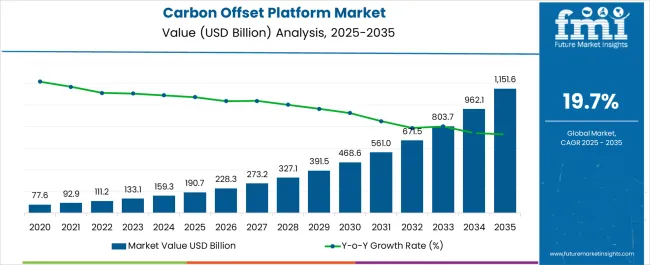
| Metric | Value |
|---|---|
| Carbon Offset Platform Market Estimated Value in (2025 E) | USD 190.7 billion |
| Carbon Offset Platform Market Forecast Value in (2035 F) | USD 1151.6 billion |
| Forecast CAGR (2025 to 2035) | 19.7% |
The carbon offset platform market is gaining strong momentum due to intensifying global commitments to net zero targets, rising carbon pricing mechanisms, and corporate sustainability programs. Governments are expanding compliance frameworks to regulate carbon-intensive industries, while private enterprises are increasingly investing in verified carbon credits to balance emissions.
Digital platforms are enhancing transparency, traceability, and efficiency by integrating blockchain and AI-driven tools, which has strengthened confidence among buyers and regulators. The demand for diversified projects such as renewable energy, afforestation, and clean technology initiatives is also accelerating adoption.
With climate financing and ESG reporting requirements becoming critical to corporate and investor strategies, the market outlook remains highly positive, paving the way for scalable solutions that support both regulatory and voluntary offset demands.
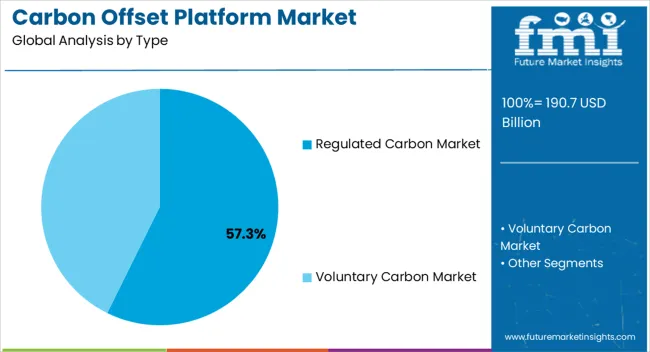
The regulated carbon market type is expected to hold 57.30% of total revenue by 2025, positioning it as the dominant segment. This leadership is driven by government mandates, compliance requirements, and the expansion of emission trading systems across major economies.
Regulated frameworks provide legal accountability, standardized verification processes, and financial incentives for compliance, which have collectively strengthened participation from heavy industries.
The growing enforcement of carbon taxes and penalties has further pushed companies to actively engage in regulated markets, reinforcing their position as the largest contributor to the carbon offset platform market.
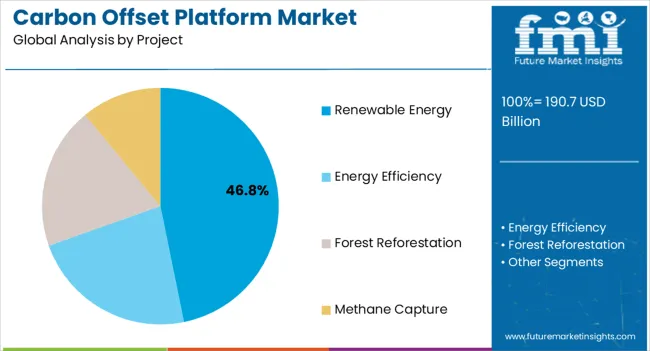
The renewable energy project segment is projected to account for 46.80% of the total revenue by 2025, making it the leading category within projects. This growth is fueled by global investments in solar, wind, and hydropower projects that generate verifiable carbon credits.
Strong policy support for clean energy transitions and attractive returns from certified renewable projects have bolstered adoption. Corporate buyers prefer renewable energy credits due to their scalability, reliability, and alignment with long-term decarbonization goals.
As a result, renewable energy projects have become the most favored pathway for organizations seeking to meet offset requirements while demonstrating climate leadership.
From 2020 to 2025, the global carbon offset platform market experienced a CAGR of 17.6%, reaching a market size of USD 190.7 million in 2025.
The demand outlook for carbon offset platform market had a significant upswing as the awareness and urgency surrounding climate change intensified. During this period, there was a notable surge in demand for carbon offsetting solutions as individuals, organizations, and governments sought to reduce their carbon footprints and contribute to global sustainability efforts.
Several factors contributed to the increased demand for carbon offset platforms during this timeframe. Moreover, there was a heightened recognition of the need to address climate change and its impacts. Scientific reports and international agreements, such as the Paris Agreement, emphasized the importance of reducing greenhouse gas emissions and limiting global warming.
As a result, there was a growing realization among individuals and entities of the necessity to take action, leading to an increased demand for carbon offsetting options.
Looking ahead, the global carbon offset platform market is expected to rise at a CAGR of 19.7% from 2025 to 2035. During the forecast period, the market size is expected to reach USD 806.1 million.
The future forecast for the carbon offset platform market is promising, driven by several factors that indicate sustained growth and expansion. Governments, corporations, and individuals are increasingly committing to net-zero emissions and sustainability goals.
This commitment will drive the demand for carbon offset platforms as organizations seek effective solutions to achieve their targets. The market is expected to benefit from the growing emphasis on sustainability and the need for credible carbon offsetting options.
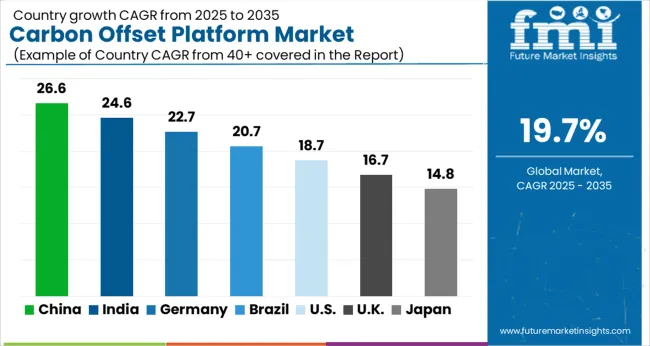
| Country | The United States |
|---|---|
| Market Size (USD million) by End of Forecast Period (2035) | USD 1151.6 million |
| CAGR % 2025 to End of Forecast (2035) | 25.9% |
The carbon offset platform industry in the United States is expected to reach a market share of USD 1151.6 million by 2035, expanding at a CAGR of 25.9%. Technological advancements, such as blockchain and data analytics, are being integrated into carbon offset platforms.
These technologies enhance transparency, traceability, and credibility, addressing concerns related to project verification and additionality. The incorporation of advanced technologies improves the efficiency and trustworthiness of carbon offset platforms, contributing to their growth. Additionally, there are other factors expected to drive the growth for carbon offset platform in the country are:
| Country | The United Kingdom |
|---|---|
| Market Size (USD million) by End of Forecast Period (2035) | USD 91.9 million |
| CAGR % 2025 to End of Forecast (2035) | 28.4% |
The carbon offset platform industry in the United Kingdom is expected to reach a market share of USD 91.9 million, expanding at a CAGR of 28.4% during the forecast period. In United Kingdom, the retail investors are more likely to invest in collection of funds, which provides detailed information about the organization’s carbon footprints and has transparent plans for reduction of the emission.
As individuals become more environmentally conscious and seek opportunities to contribute to climate action, they are turning to carbon offset platforms.
These platforms offer accessible and user-friendly solutions for retail investors to offset their carbon emissions and support verified offset projects.
Moreover, The United Kingdom's Net Zero strategy is playing a significant role in driving the carbon offset platform market. The government has committed to achieving net-zero greenhouse gas emissions by 2050. To accomplish this, the government has implemented various initiatives and policies, including support for carbon offsetting.
| Country | China |
|---|---|
| Market Size (USD million) by End of Forecast Period (2035) | USD 190.7.0 million |
| CAGR % 2025 to End of Forecast (2035) | 26.6% |
The carbon offset platform industry in China is anticipated to reach a market share of USD 190.7.0 million, moving at a CAGR of 26.6% during the forecast period. China had a commitment for cutting overall greenhouse gas (GHG) emissions by 26 to 28 percent by the year 2025. China recognizes the importance of environmental supervision and sustainable development.
By promoting and using a carbon offset platform, China can demonstrate its commitment to mitigating climate change and addressing environmental challenges. It helps to build a positive image for the country on the global stage and highlight its efforts towards sustainability.
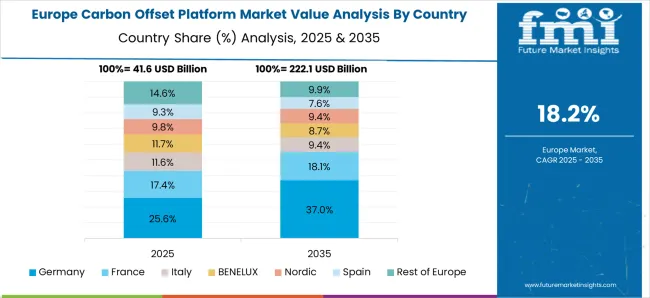
| Country | Germany |
|---|---|
| Market Size (USD million) by End of Forecast Period (2035) | USD 71.7 million |
| CAGR % 2025 to End of Forecast (2035) | 23.5% |
The carbon offset platform industry in Germany is estimated to reach a market share of USD 71.7 million by 2035, thriving at a CAGR of 23.5%. According to United Nations Framework Convention in Climate Change (UNFCCC), In Germany, the transport sector has approximately 23% of the total energy, which is related to CO2 global emissions.
The German government in inclined towards tackling this situation of carbon emission of business travels by making use of carbon credits that are obtained from the projects. The government of Germany is making sure that these projects are certified and fall under the United Nations rules of Clean Development Mechanism (CDM).
Moreover, there is an increasing number of companies, citizens and government initiatives to reduce the carbon footprints and moving towards to tackle the climate change. Due to these collective efforts in Germany, the market for carbon offset platform is expected to grow over the forecasted period.
| Country | India |
|---|---|
| Market Size (USD million) by End of Forecast Period (2035) | USD 68.5 million |
| CAGR % 2025 to End of Forecast (2035) | 28.0% |
The carbon offset platform industry in India is expected to reach a market share of USD 68.5 million, expanding at a CAGR of 28.0% during the forecast period. India is on the verge of selling carbon credits on the global scale, in concurrence with the Article 6.2 of Paris Agreement. Within this movement, India is making sure to attract investors in the carbon offset market.
Due to this initiative by Indian government, the local carbon offset vendors have the opportunity to step forward and provide the solutions on a global level. Moreover, the demand of voluntary carbon market is creating opportunities in India. India has the potential to create high quality carbon credits through the help of project that has socio-economic co-benefits.
The regulated carbon market segment is expected to dominate the carbon offset platform industry with a CAGR of 20.1% from 2025 to 2035. Regulatory frameworks often require businesses to meet emission reduction targets or comply with cap-and-trade systems.
This creates a mandatory demand for carbon offsets, as companies seek to fulfill their compliance obligations. The regulated carbon market facilitates the trade and availability of offsets, enabling participants in the carbon offset platform market to meet this increased demand and capitalize on the mandatory offset requirements.
The simple reason why the renewable energy projects are estimated to be a major end use for the carbon offset platforms is because of the major investments that are taking place for the development of renewable energy sources.
Governments and private companies are investing in the development of solar farms, wind farms, and hydroelectric power plants.
According to a survey conducted by BP (British Petroleum) in 2020, majority of the energy generated across the world was from coal, natural gases and oil. All these sources of energy are pollutants, especially coal because it the largest polluter among the three.
Governments are taking steps to reduce their reliance upon these fossil fuels, but it can only be successful when the renewable sources of energy are well developed. This is the primary factor that is driving the development of renewable energy projects globally, indirectly allowing the growth of carbon offset platforms at a CAGR of 23.2% over the forecast period.
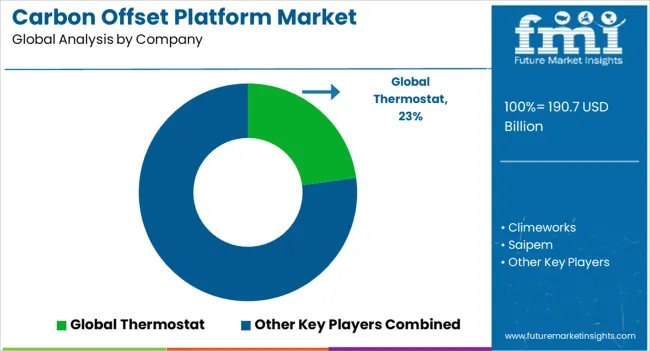
The key players of carbon offset platform market have an immense competition among them due to diverse projects having high transparency. Due to continuous investment in technological advancements to enhance their platform's functionality, user experience, and efficiency.
In such a scenario, key players must adopt effective strategies to stay ahead of the competition.
Key Strategies Adopted by the Players
Product Innovation
Companies focus on continuous product innovation to enhance their carbon offset platforms. They invest in research and development to improve user experience, platform functionality, and the efficiency of offset project management.
Innovation may involve incorporating new technologies like blockchain for transparent and secure transactions, implementing advanced analytics for project selection and tracking, or introducing user-friendly interfaces and tools for customers to manage their carbon offsets effectively.
Strategic Partnerships and Collaborations
Companies form strategic partnerships and collaborations with various stakeholders to expand their reach and offerings. They collaborate with project developers, environmental organizations, and certification bodies to access a diverse range of high-quality offset projects.
Partnerships with corporations enable the integration of carbon offset options into their sustainability strategies, providing a broader customer base. Collaborations with governments and non-profit organizations foster alignment with climate goals and enable regulatory compliance.
Expansion into Emerging Markets
Companies explore opportunities in emerging markets with growing sustainability needs and increasing demand for carbon offset platforms. They identify regions with supportive regulatory frameworks, rising environmental consciousness, and growing corporate interest in sustainability.
By expanding into these markets, companies can establish a strong foothold, capture market share, and tap into new customer segments. This expansion may involve localized marketing strategies, partnerships with local entities, and customization of platform offerings to meet specific regional requirements.
Mergers and Acquisitions
Companies pursue mergers and acquisitions to consolidate their position in the market, expand their capabilities, and gain a competitive advantage. Strategic acquisitions may involve acquiring complementary businesses, such as project developers or offset verification firms, to enhance the breadth and depth of their offerings.
Mergers with other carbon offset platform providers enable synergies in technology, customer base, or geographical coverage.
Key Players in the Carbon Offset Platform Industry
Key Developments in the Carbon Offset Platform Market:
The global carbon offset platform market is estimated to be valued at USD 190.7 billion in 2025.
The market size for the carbon offset platform market is projected to reach USD 1,151.6 billion by 2035.
The carbon offset platform market is expected to grow at a 19.7% CAGR between 2025 and 2035.
The key product types in carbon offset platform market are regulated carbon market and voluntary carbon market.
In terms of project, renewable energy segment to command 46.8% share in the carbon offset platform market in 2025.






Full Research Suite comprises of:
Market outlook & trends analysis
Interviews & case studies
Strategic recommendations
Vendor profiles & capabilities analysis
5-year forecasts
8 regions and 60+ country-level data splits
Market segment data splits
12 months of continuous data updates
DELIVERED AS:
PDF EXCEL ONLINE
Carbon Enhanced Lead Acid Battery Market Size and Share Forecast Outlook 2025 to 2035
Carbon-negative Cement Market Size and Share Forecast Outlook 2025 to 2035
Carbon Tetrabromide Market Size and Share Forecast Outlook 2025 to 2035
Carbon Steel Market Size and Share Forecast Outlook 2025 to 2035
Carbon Brush Market Size and Share Forecast Outlook 2025 to 2035
Carbon Tapes Market Size and Share Forecast Outlook 2025 to 2035
Carbon-Free Waste Gas Abatement System Market Size and Share Forecast Outlook 2025 to 2035
Carbon Labeled Packaged Meal Market Analysis - Size and Share Forecast Outlook 2025 to 2035
Carbon Fiber Bike Wheelset Market Size and Share Forecast Outlook 2025 to 2035
Carbon Dioxide Lasers Market Size and Share Forecast Outlook 2025 to 2035
Carbon-negative Packaging Market Size and Share Forecast Outlook 2025 to 2035
Carbon Fiber Construction Repair Market Size and Share Forecast Outlook 2025 to 2035
Carbon Credit Market Size and Share Forecast Outlook 2025 to 2035
Carbon-Dioxide Synthesis Cosmetics Market Size and Share Forecast Outlook 2025 to 2035
Carbon-Neutral Skincare Ingredients Market Analysis - Size and Share Forecast Outlook 2025 to 2035
Carbonate Market Size and Share Forecast Outlook 2025 to 2035
Carbon Fiber Reinforced Plastic Market Size and Share Forecast Outlook 2025 to 2035
Carbon Fiber Wraps Market Size and Share Forecast Outlook 2025 to 2035
Carbon Fiber Boat Hulls Market Size and Share Forecast Outlook 2025 to 2035
Carbon Textile Reinforced Concrete Market Size and Share Forecast Outlook 2025 to 2035

Thank you!
You will receive an email from our Business Development Manager. Please be sure to check your SPAM/JUNK folder too.
Chat With
MaRIA